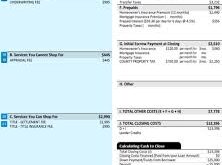Mortgage Underwriting Process: A Complete Guide to Approval. When applying for a mortgage, the mortgage underwriting process is a crucial step in determining whether your loan will be approved. Underwriting is the lender’s way of assessing risk and ensuring that borrowers can repay their loans. Understanding this process can help you navigate home financing more efficiently and improve your chances of approval.
What Is the Mortgage Underwriting Process?
The mortgage underwriting process is the lender’s evaluation of your financial background to determine if you qualify for a home loan. The process includes verifying income, assets, debt, credit history, and the property’s value. Mortgage underwriters use this data to decide if the loan meets the lender’s criteria.
Key Steps in the Mortgage Underwriting Process
1. Loan Application Submission
The mortgage process starts with submitting a loan application, known as a Uniform Residential Loan Application (URLA). This application includes details about your income, employment, credit history, debts, and assets.
2. Credit Report Review
Lenders pull your credit report to assess your credit score, payment history, outstanding debts, and credit utilization. A high credit score improves approval chances, while a low score may require additional documentation or result in higher interest rates.
3. Income and Employment Verification
Lenders verify income through pay stubs, W-2s, tax returns, and employment verification letters. Self-employed borrowers must provide profit and loss statements and bank statements.
4. Debt-to-Income (DTI) Ratio Calculation
The DTI ratio compares your monthly debt payments to your gross income. Most lenders prefer a DTI ratio below 43%, though some loans allow higher ratios with compensating factors.
5. Asset Verification
Lenders check your bank accounts, investments, and other assets to ensure you have sufficient funds for the down payment, closing costs, and reserves. Large deposits may require explanation to rule out undisclosed loans.
6. Property Appraisal
The lender orders an appraisal to confirm the property’s market value. If the home’s value is lower than the loan amount, renegotiation may be necessary, or the borrower may need to cover the difference.
7. Underwriting Decision
The underwriter assesses all collected data and makes one of the following decisions:
- Approved: The loan meets all requirements and is ready for closing.
- Approved with Conditions: Additional documentation or explanations are required.
- Suspended: Incomplete or missing documents must be provided.
- Denied: The loan does not meet underwriting requirements.
8. Loan Approval and Closing
Once all conditions are met, the lender issues a clear-to-close (CTC). The borrower then signs final documents, pays closing costs, and receives loan funds.
Factors That Affect Mortgage Underwriting
Several factors influence underwriting decisions, including:
- Credit Score: Higher scores lead to better loan terms.
- Income Stability: Consistent employment history is favorable.
- Debt Load: High debts may lead to rejection or higher rates.
- Down Payment Size: Larger down payments reduce risk for lenders.
- Loan Type: Different loans have varying requirements.
Common Reasons for Mortgage Denial
- Low Credit Score – Poor credit history lowers approval chances.
- High DTI Ratio – Excessive debt compared to income.
- Insufficient Income – Lenders require stable, verifiable income.
- Unverified Assets – Lack of documented funds for down payments.
- Property Appraisal Issues – If the home value is too low, the loan may not be approved.
10 Tips to Improve Mortgage Underwriting Approval
- Check Your Credit Report: Correct errors before applying.
- Pay Off Debt: Lower your DTI ratio by reducing debt.
- Save for a Higher Down Payment: A larger down payment lowers risk.
- Maintain Stable Employment: Avoid job changes before closing.
- Provide Complete Documentation: Submit all required financial records.
- Avoid New Credit Applications: New debt can lower your score.
- Increase Your Income: Side jobs or additional income sources help.
- Explain Large Deposits: Provide documentation for any significant account deposits.
- Choose the Right Loan Type: Research which mortgage fits your financial situation.
- Work With a Mortgage Broker: They can help you find the best loan options.
10 Frequently Asked Questions About Mortgage Underwriting
1. What does a mortgage underwriter look for?
Underwriters evaluate credit, income, assets, and the property’s value to assess loan eligibility.
2. How long does underwriting take?
It typically takes one to two weeks, but complex cases may take longer.
3. Can a loan be denied after pre-approval?
Yes, if financial conditions change or issues arise during underwriting.
4. What happens if my loan is conditionally approved?
You must submit additional documentation before final approval.
5. How can I speed up the underwriting process?
Providing complete and accurate documentation upfront helps avoid delays.
6. Does a high credit score guarantee approval?
No, but it improves your chances and helps secure better loan terms.
7. Can I apply for a mortgage with a high DTI ratio?
Some loan programs allow higher DTI ratios if compensating factors exist.
8. What if my appraisal is lower than expected?
You may need to renegotiate the purchase price or provide a larger down payment.
9. Can I switch jobs during mortgage underwriting?
It’s not recommended, as lenders prefer job stability.
10. What if my loan is denied?
You can improve your credit, reduce debt, or apply with a different lender.
Conclusion
The mortgage underwriting process is a vital step in home financing, ensuring that borrowers meet lenders’ risk standards. By understanding the process, preparing financial documents in advance, and maintaining strong credit, you can improve your chances of securing a mortgage. If your loan is denied, take steps to address the issues and reapply when financially ready.
Navigating underwriting successfully requires patience and financial discipline. Whether you’re a first-time homebuyer or refinancing, being proactive and well-prepared will help you secure a favorable mortgage and achieve your homeownership goals.
 mortgage.kbk.news
mortgage.kbk.news
